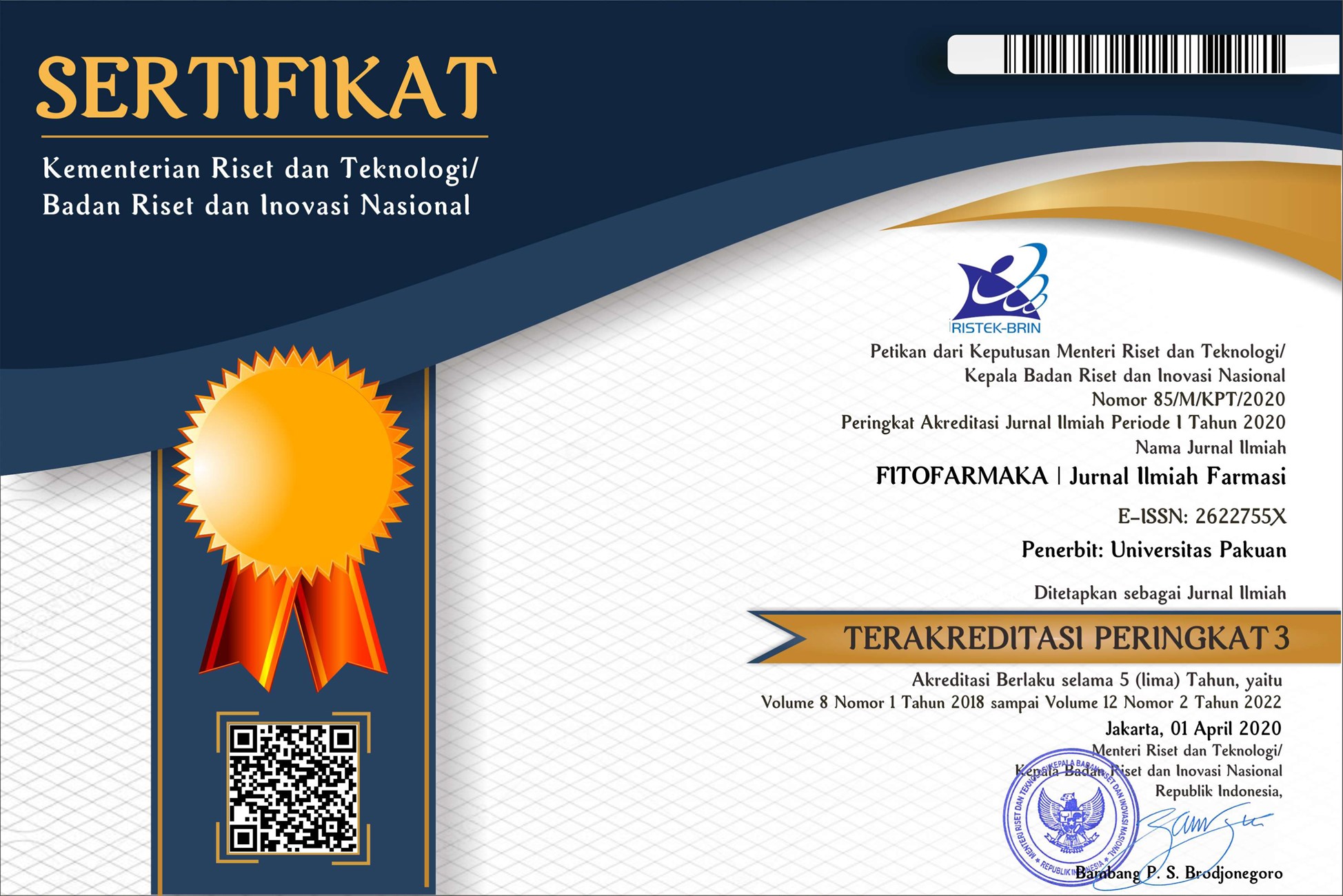UJI AKTIVITAS PENGHAMBATAN XANTIN OKSIDASE EKSTRAK ETANOL 80% DARI TANAMAN FAMILI COMBRETACEAE, LAURACEAE, LYTHRACEAE, OXALIDACEAE, PIPERACEAE, PLUMBAGINACEAE, DAN SMILACACEAE
Abstract
ABSTRAK
Hiperurisemia dapat disebabkan oleh produksi berlebih dan kurangnya ekskresi asam urat dalam tubuh. Xantin oksidase adalah enzim yang memiliki peran mengkatalisis oksidasi hipoxantin dan xantin menjadi asam urat. Tujuan penelitian ini adalah untuk mengetahui tanaman obat yang memiliki aktivitas penghambatan xantin oksidase dan mengidentifikasi golongan senyawa kimianya. Metode yang digunakan adalah Continous Spectrophotometric Rate Determination. Serbuk simplisia diekstrak dengan cara refluks menggunakan pelarut etanol 80%. Dengan uji aktivitas penghambatan xantin oksidase didapatkan ekstrak yang memiliki aktvitas penghambatan, yaitu ekstrak herba suruhan (Peperomia pellucida (L.) Kunth), ekstrak daun blimbing wuluh (Averrhoa bilimbi L.), ekstrak daun sirih (Piper betle L.), dan ekstrak kulit kayu manis (Cinnamomum burmannii Nees ex Blume) yang memiliki nilai IC50 berturut-turut 2621,07 ppm, 1149,113 ppm, 245,30 ppm, dan 1294,58 ppm. Identifikasi kimia pada ekstrak herba suruhan menunjukkan adanya alkaloid, flavonoid, tanin, saponin, dan glikosida. Pada ekstrak daun belimbing wuluh mengandung senyawa flavonoid, tanin, dan saponin. Pada eksktrak daun sirih hijau mengandung senyawa alkaloid, flavonoid, tanin, saponin, dan antrakuinon. Pada ekstrak kulit kayu manis mengandung senyawa alkaloid, flavonoid, tanin, saponin
Kata kunci: suruhan, blimbing wuluh, sirih, kayu manis, hiperurisemia, aktivitas inhibitor, xantin oksidase
References
DAFTAR ACUAN
Departemen Kesehatan Republik Indonesia. (1995), Farmakope Indonesia edisi IV. Jakarta: Departemen Kesehatan Republik Indonesia.
Egwuche, R. U., Odetola, A. A., Erukainure, O. L. (2011). Preliminary Investigation into the Chemical Properties of Peperomia pellucida L. Research Journal of Phytochemistry, 5 (1), 48-53.
Gonzalez, A. G., Bazzochi, I. L., Moujir, L., Ravelo, A. G., Correa, M. D., Gupta, M. P. (1995). Xanthine Oxidase Inhibitory Activity of Some Panamian Plants from Celatraceae and Lamiaceae. Journal of Etnopharmacology, 46, 25-29.
Harborne, J.B. (1987). Metode Fitokimia. Ter. Dari Phytochemical Methods oleh Kosasih Padmawinata dan Iwang Soediro. Bandung: Penerbit ITB.
Kong, L. D., Cai, Y., Huang, W. W., Cheng, C. H. K., Tan, R. X. (2000). Inhibition of Xanthine Oxidase by Some Chinese Medicinal Plants Used to Treat Gout. Journal of Ethnopharmacology, 73, 199–207.
Murata, K., Nakao, K., Hirata, N., Namba, K., Nomi, T., Kitamura, Y., Moriyama K., Shintani T., Iinuma, M., Matsuda, H. (2009). Hydroxichavicol: A potent xanthine oxidase inhibitor obtained from the leaves of betel, Piper betle. Journal of Natural Medicine, 63, 355-359.
Owen, P.L., Johns, T. (1999). Xanthine oxidase inhibitory activity of Northeasthern North American plant remedies used for gout. Journal of Ethnopharmacology . 64, 146.
Umamaheswari, M., Asokkumar, K., Somasundaram,A.,Sivashanmugam, T., Subhadradevi, V., Ravi, T.K. (2007). Xanthine oxidase inhibitory activity of some Indian medical plants. Journal of Ethnopharmacology, 109, 547–551.
Umamaheswari, M., Asokkumar, K., Sivashanmugam,A.T.,Remyaraju, A., Subhadradevi, V., Ravi, T.K. (2009). In vitro xanthine oxidase inhibitory activity of the fractions of Erythrina stricta Roxb. Journal of Ethnopharmacology, 124, 646–648.
Van Hoorn, D.E.C., Nijveldt, R.J., Van Leuween P.A.M., Hofman, Z., M’Rabet, L., De Bont, D.B.A.Van Norren, K. (2002). Accurate Prediction of Xanthine Oxidase Inhibtion Based on the Structure of Flavonoids. European Journal of Pharmacology, 451, 111-118.
DOI: 10.33751/jf.v6i2.757
 Abstract views : 2610
Abstract views : 2610
Refbacks
- There are currently no refbacks.













